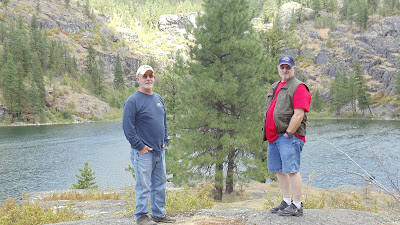I can hear waterfalls here at our camping spot at Emigrant Springs State Park in the Umatilla National Forest in northeast Oregon. Actually, I’m not hearing waterfalls. I’m hearing traffic. Loud traffic. Because except for a frontage road, Emigrant Springs State Park is immediately adjacent to I-84, the big freeway that crosses Oregon from its southeast corner up toward and into Portland. But pretending makes it a little better.
On the other hand, the park is near an original section of the Old Oregon Trail where pioneers camped and replenished water supplies from springs. Later this part of the trail became I-84. So if you are going to put a park in the original location, I-84 is going to be right there with you.
Other than the sound of the semis (on the plus side, I have yet to hear the rapid “brp, brp, brp, brp brp” sound of compression brakes) this is a great campground. It’s pretty, well-cared for, has big conifers and roomy campsites.
Since we’ve arrived, we’ve been hiking and taking it easy. Today we also took a trip into La Grande, a town of about 13,000 people and the largest city nearby (and that got its name from an early French settler who used the term to describe the area's scenery). We had lunch and did a little exploring. Tomorrow we’re heading southeast for a campground on the Snake River near the Idaho/Oregon border.
 |
| One of 7 cabins for rent at Emigrant Springs. These are the nicest rental cabins I’ve seen at a state park. |





















































